* (restored)
________________

Gadget: Invention, Travel, & Adventure (1993)
‘Gadget: Invention, Travel, & Adventure is a videogame or interactive movie, first released by Synergy Interactive in 1993. It was directed and designed by the Japanese computer graphics artist Haruhiko Shono. For his striking visual style and his mastery of lavish computer graphics at the dawn of the point-and-click adventure game genre, Newsweek named him one of the “most influential people to watch in Cyberspace,” and coined the term “cybergames” to describe his highly-realistic visual games whose visual style have been compared to those of Cyan’s 1993 best-seller, Myst. Gadget resembles a point-and-click adventure game similar to Myst, but with a strictly linear storyline culminating in a fixed finale. Thus it tends to be classified more as an interactive movie rather than a videogame. The story centers around a future dominated by retro technology from the 1920s and 1930s, especially streamlined locomotives and flying machines.
‘The game’s plot takes place in an unspecified (albeit vaguely Eastern European) nation headed by the dictator Orlovsky. The protagonist is a government agent tasked with discovering the whereabouts of a missing scientist named Horselover Frost. He begins his quest in a third-floor room of a luxury hotel (which is in fact the headquarters of the government’s intelligence arm). After collecting his belongings in a suitcase, the protagonist takes an elevator ride to the lobby, during which a boy replaces the case with another identical one containing various spy-related paraphernalia. In the lobby, the government’s intelligence chief briefs the protagonist on his mission. The protagonist then moves to the central railway station. From this point on all the events of the story take place on trains or at the various stations (which include the national science institute) along the nation’s main rail line. The player must engage in scripted conversations with various individuals, each of whom reveals pieces of information that advance the protagonist in his quest.’ — collaged



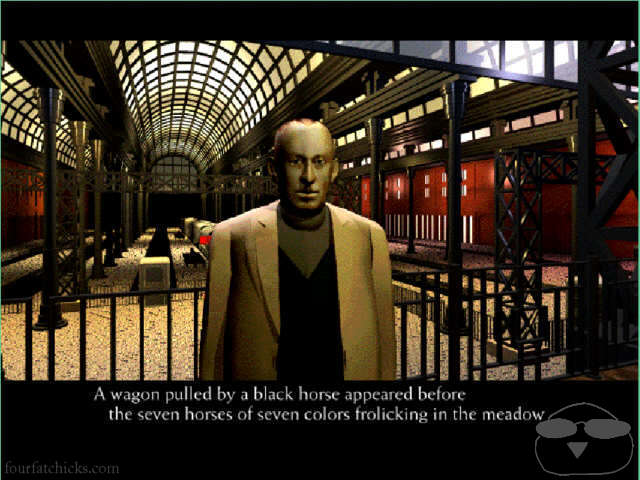

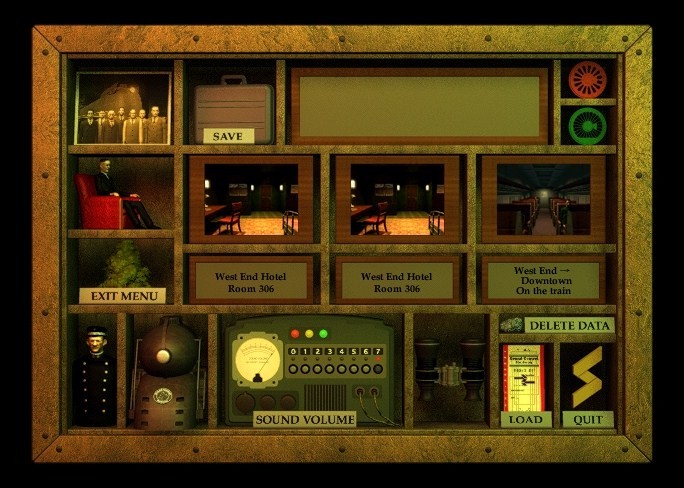
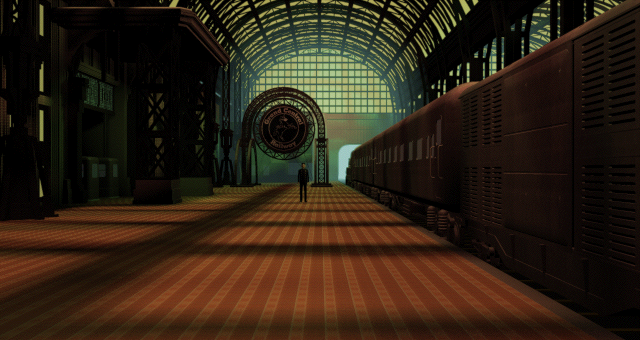
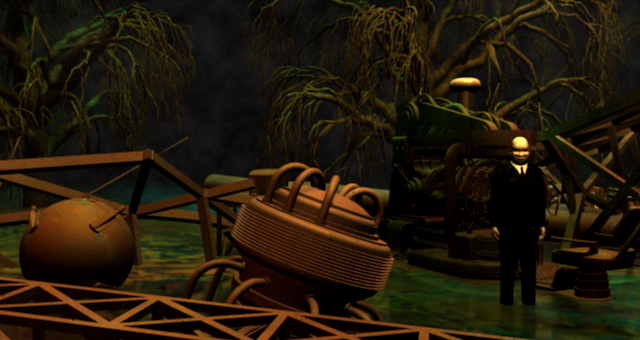

Playthrough
______________

Dust: A Tale Of The Wired West (1995)
‘Dust: A Tale Of The Wired West is an American computer game made for the PC and the Macintosh. It was released on June 30, 1995 and was produced by Cyberflix and published by GTE Entertainment. The game is a point and click western adventure game in which the player, playing a character called The Stranger, travels around a virtual old western desert town in the New Mexico desert in 1882. The characters encountered in Dust are rendered by way of photographs of professional actors given limited animation in sync with dialogue. A later game produced by the same company, Titanic: Adventure Out of Time, uses the same technique.
‘The game begins with a sort of short story. The Stranger, or you, is playing 5-card draw poker with a person named the Kid, the villain of the game in a Saloon. When the Stranger bets his knife, the Kid throws his cards down, and reveals that he has a four of a kind of Aces, with a king for good measure. It beats your full house. As he reaches out to get his share, a Saloon woman remarks that his arm reveals another Ace; meaning he cheated. Infuriurated that the Kid tried to cheat, you stab him in the hand with the knife. The Kid draws his gun, but you’re a quick thinker and throw the table up as a barricade. The Kid fires into the air. The view changes to outside the Saloon. Two more shots are heard, than the Stranger runs out of the Saloon. We can hear a saloon patron yell the words, “Run, Stranger!”
‘After that, the Cyberflix logo flashes on the screen, followed by a series of screens depicting the Stranger walking through a hot, desolate desert. As this happens, the credits roll, and an elderly sounding narrator begins to speak.
‘”The Stranger may have bested The Kid, but he had paid dearly for the privilege. He had no gun, no friends, and only a few dollars in his pocket. If he wanted to live longer than tomorrow, he’d have to find these things. Was he desperate? Let’s be charitable; The Stranger, WAS, when we first met him, crow bait! Granted, Diamondback may not have looked like much either, still, we had everything he needed to survive!” — collaged
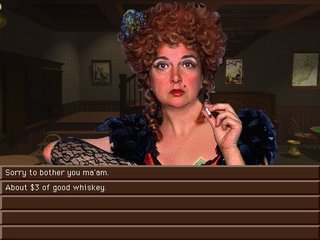
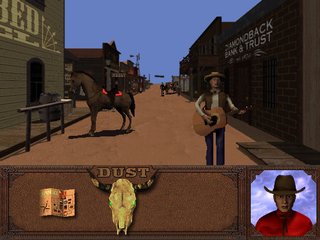
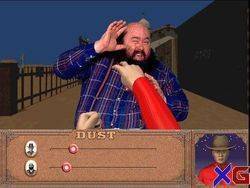





Dust: A Tale of the Wired West partial play through
________________
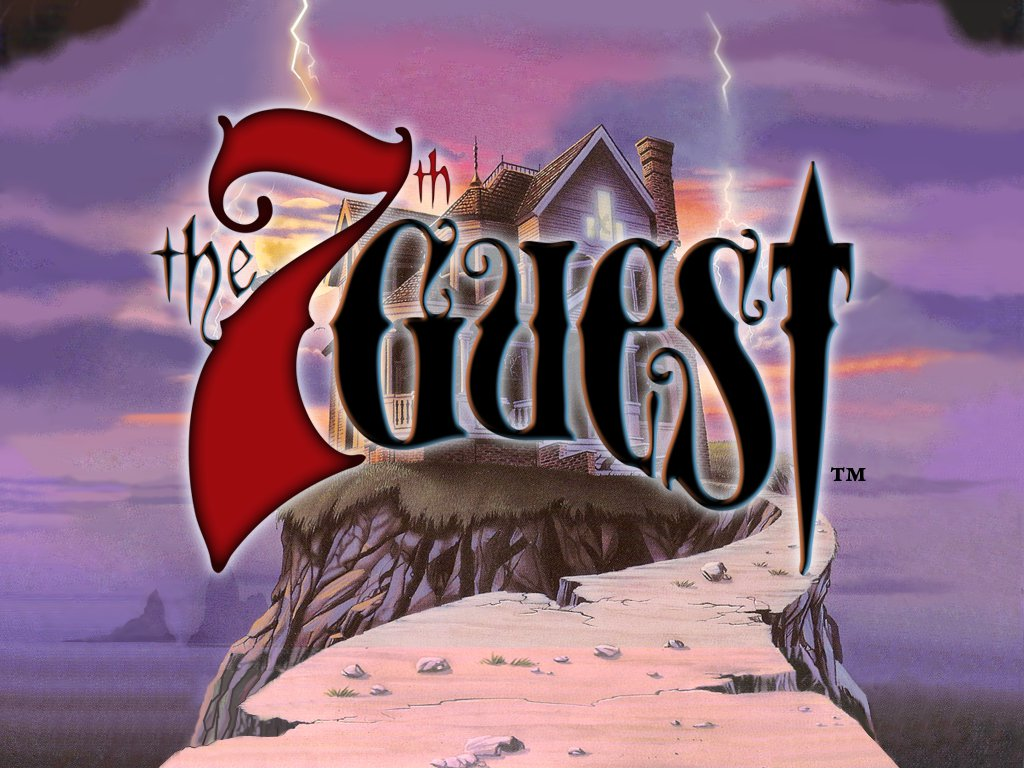
The 7th Guest (1993)
‘The 7th Guest, produced by Trilobyte and released by Virgin Games in 1993, is an interactive movie puzzle adventure game. It was one of the first computer video games to be released only on CD-ROM. The 7th Guest is a horror story told from the unfolding perspective of the player, as an amnesiac. The game received a great amount of press attention for making live action video clips a core part of its gameplay, for its unprecedented amount of pre-rendered 3D graphics, and for its adult content. In addition, the game was very successful, with over two million copies sold, and is widely regarded as a killer app that accelerated the sales of CD-ROM drives.
‘The 7th Guest takes place inside an abandoned mansion. Venture into the 22 rooms of the spooky mansion, solve over 20 mind-bending puzzles to unravel a tale of revenge and horror that took place in the 1930s. The owner of the mansion was Henry Stauf, a famous maker of children’s toys. Once a homeless drifter and thief, influenced by a vision in a dream, Henry invented a wondrous doll, so incredibly life-like that it sold like wildfire. Stauf’s toys became popular overnight bringing fame and fortune and changing his rags to riches. But things took a tragic turn when owners of the doll became infected with a fierce and deadly virus. None of those children recovered.
‘After this turn of events Stauf secluded himself inside his estate, stopped making his toys and never came into contact with the outside world for a long time. Something very strange happened when six people receive an invitation to a party at the mansion. By solving the riddles inside Stauf’s “fun house”, you’ll delve into the past to learn what happened to them, and the mysterious 7th guest, on that fateful night. To finish the game, you must solve the puzzles in Stauf’s manor; each solved puzzle will unlock new rooms or new movie sequences to watch. The puzzles are quite varied; there’s the classic “eight queens puzzle”, another puzzle where you need to compose a sentence by rearranging letters, and others. If you get stuck, you can visit the library; a book within will give you hints on the puzzle. If the hints aren’t enough, the puzzle will solve itself automatically once you consult the book enough times.’ — collaged
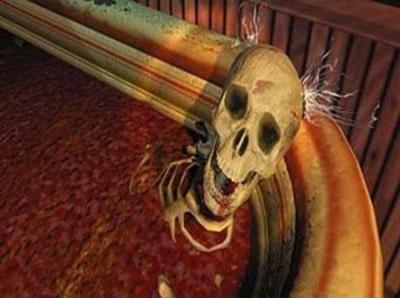


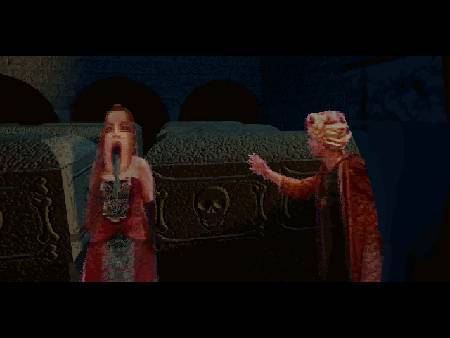
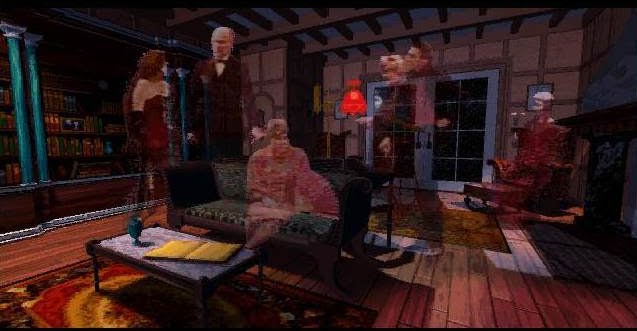
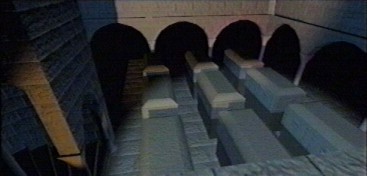

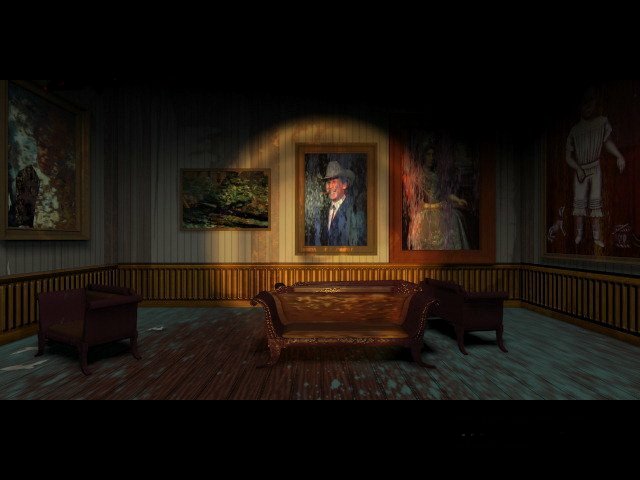

Full Game
__________________

The Journeyman Project 2: Buried in Time (1995)
‘The Journeyman Project 2: Buried in Time is a computer game developed by Presto Studios and is the second game in the Journeyman Project series of computer adventure games. Published in 1995 by Sanctuary Woods, Buried in Time was a radical change from the original. It is noted for establishing Agent 5 (the player’s character) as Gage Blackwood, which in the original Journeyman Project lacked basic personality features and even a name. It also featured greatly improved graphics and seamless animation as well as many live-action sequences. The PC version was programmed entirely in C++ for improved performance. A PlayStation version was also prototyped, but was never released.
‘As the story begins in the year 2318, six months after the events of the first game, Gage Blackwood (once again controlled by the player) is visited by himself from ten years in the future. Someone has framed the future Gage for tampering with historical artifacts and it is up to the past Gage to visit the past and find evidence to clear his name. Meanwhile, the Symbiotry of Peaceful Beings is deliberating on Earth’s monopoly on time travel technology and this latest trial threatens to close down the Temporal Security Agency (TSA). After joining up with an interesting artificial intelligence being named Arthur, Gage visits locations such as the workshop of Leonardo da Vinci and the Mayan temple of Chichen Itza and eventually find the culprit, Michelle Visard, who is another TSA agent. Gage is kidnapped by her and taken to an old missile silo, where Arthur sacrifices himself to allow Gage to continue his mission. He eventually uncovers that another alien race, the Krynn, are behind the crimes and the framing of Gage, to further their own interests. Gage is able to stop the Krynn and save his future self, and is then mind-wiped and sent back to his own time.’ — collaged


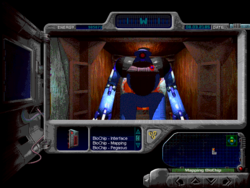
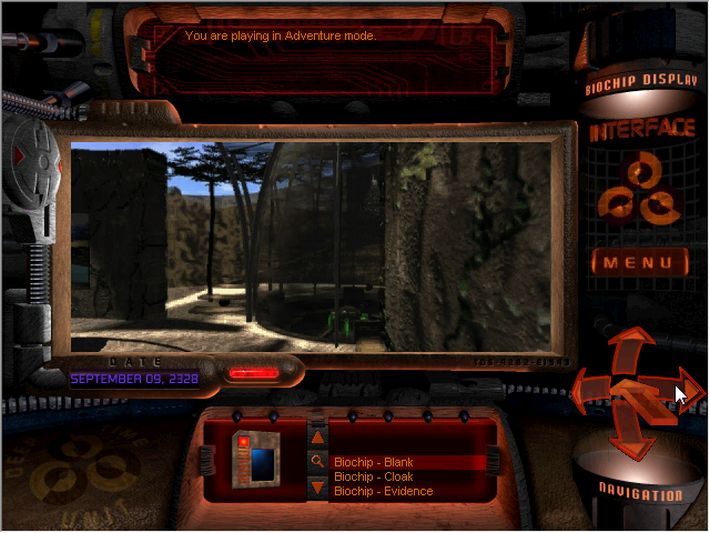
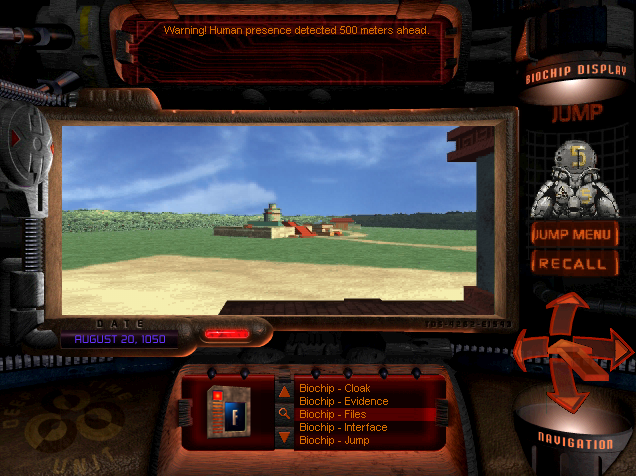

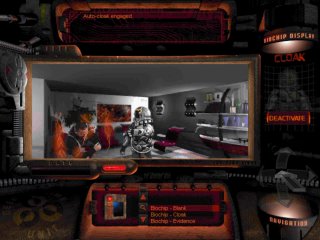

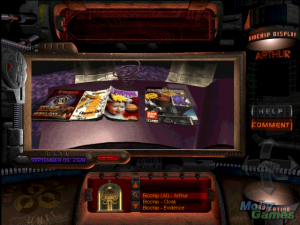
Trailer
________________
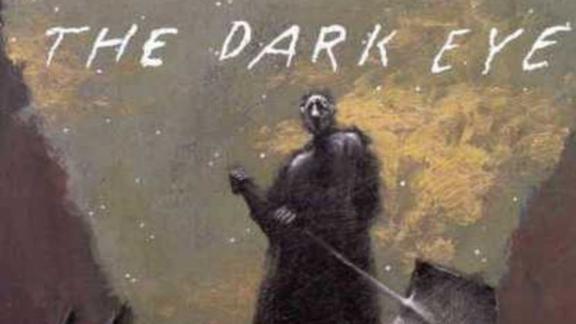
The Dark Eye (1995)
‘Back in the mid 1990s, some unique stuff happened in gaming, but few things are weirder than the bizarre PC adventure game The Dark Eye: A puppet adventure game based on the works of Edgar Allan Poe and starring one of the 20th century’s most influential authors, William S. Burroughs. The game was released in 1995 for the PC by the now-defunct software company Inscape. Upon its release the game attracted little attention from either critics or consumers, though it has received some attention since and, arguably, cult status.
‘The game featured combined 3-D graphics, clay animation (claymation) and video segments. With its unconventional interface, storyline, and characters, the game’s peculiarity became its selling point. The characters are largely lifelike in appearance except for their clay-modeled faces, which are often distorted or feature grotesquely exaggerated features. This near-realism, sometimes referred to as the uncanny valley, contributed to the game’s ambience of unease and anxiety.
‘The character animation is stop-motion. Inscape did the art design of the puppets (lead artist Bruce Heavin) and had a Hollywood house actually make them. Inscape then hired two stop-motion animators and Russell Lees spent many, many hours in a hot, dark warehouse directing the animations. The working hours were from 7 am to 7 pm for about a month. They created computer-generated screenshots of the environments and shot against blue-screen, and they had a director of photography light them to match the environment.’ — collaged
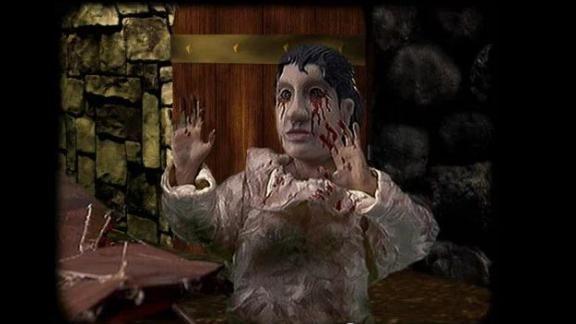
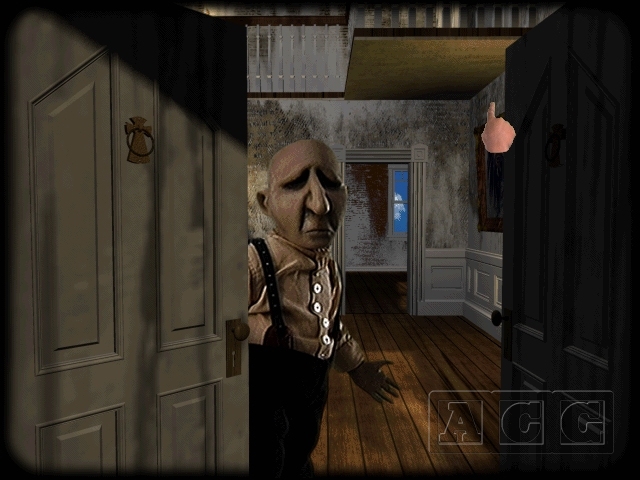
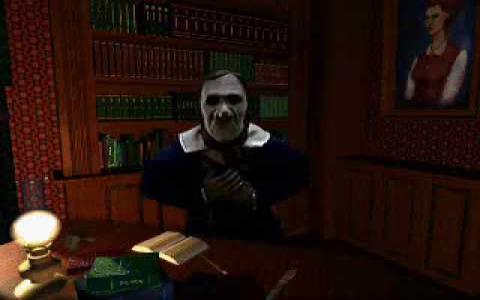
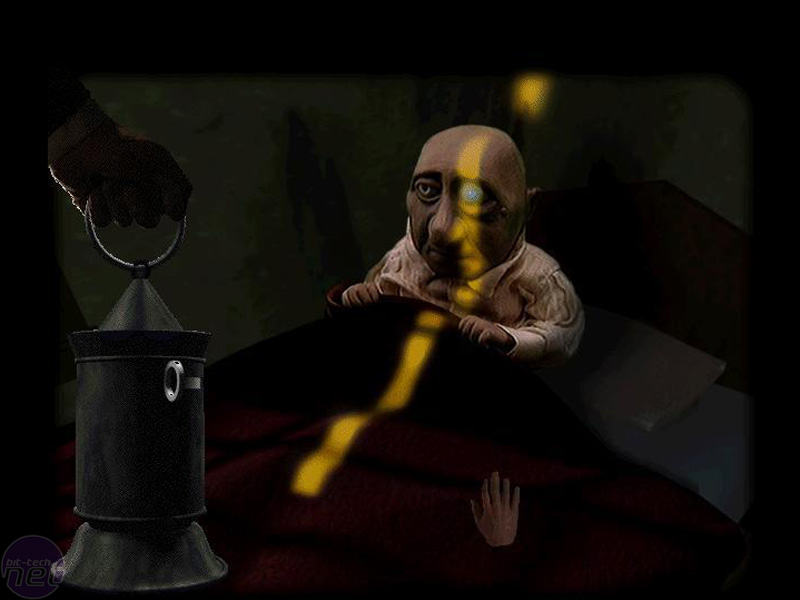
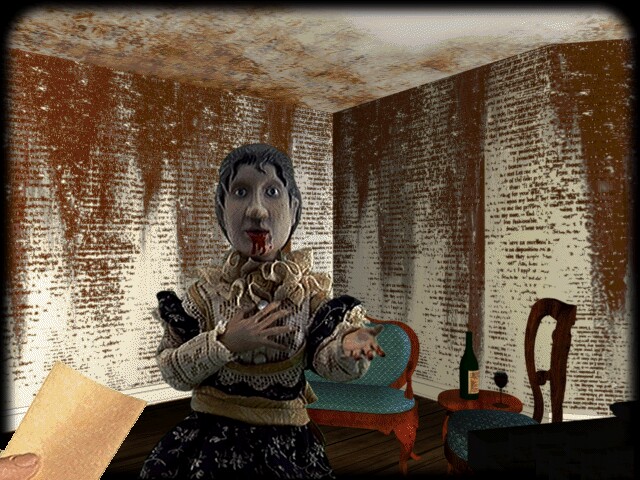
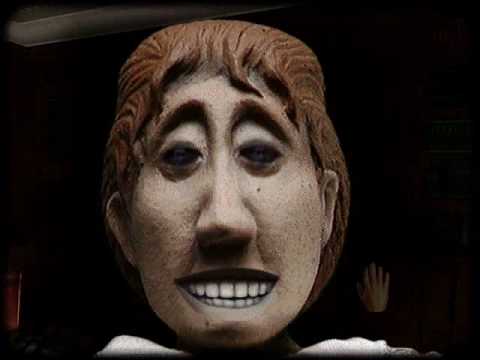
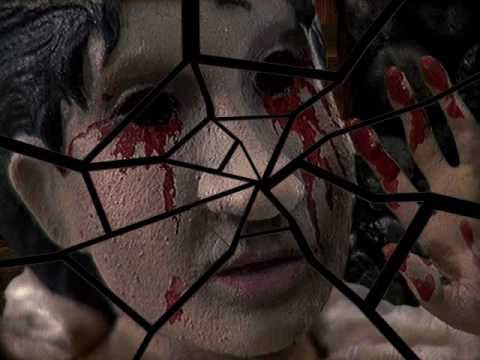

Part 1- Introduction
_________________
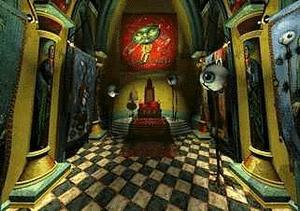
9: The Last Resort (1996)
‘9: The Last Resort is a 1996 adventure computer game developed by Tribeca Interactive. The game came soon after the release of Myst, which revolutionized the graphic adventure genre. Like Myst, 9 is a graphically-rich 3D prerendered world, taking advantage of high-quality QuickTime video, and solely available on CD-ROM. It was written for the Windows and the Mac OS platforms, unlike most games of the time which ran on DOS platform as well/instead.
‘9 features a large cast of characters, and is rich in character interaction. The game world is populated by bizarre environments, objects and creatures. The game world is designed to represent the limits of man’s imagination. There is a strong musical theme running through the entire game, as evidenced by a majority of the puzzles, including the main recurring puzzle. There is also a strong element of humour in the game.
‘Many of the game’s puzzles are based in a specific musical instrument, such as the drums, guitar, and organ; however, no musical knowledge of these instruments is required to enjoy this game. The gameplay centers on an organ upon which the player can play musical codes. On each “floor” of the resort, the player finds a code sheet containing instructions for playing a short musical piece on the organ. However, each sheet extends the code making it more difficult to interpret. This culminates in the final puzzle in which the player must be thoroughly familiar with the code. This concept has been regarded by players as either a blessing or a curse. The gameplay, coupled with the extremely high hardware requirements and the high cost of the game led to very few sales, and the game was remaindered.’ — collaged

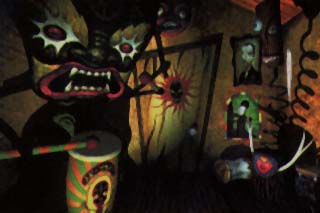
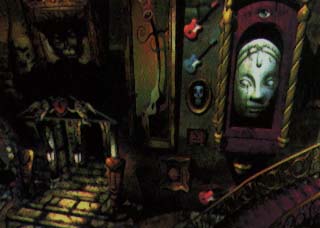
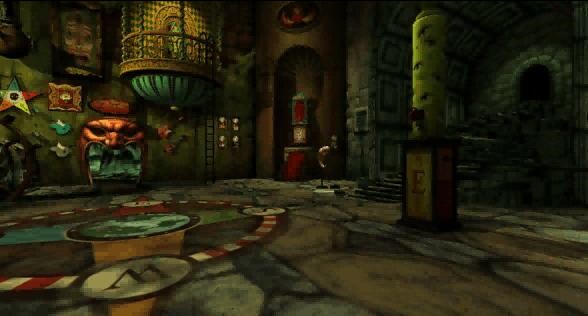
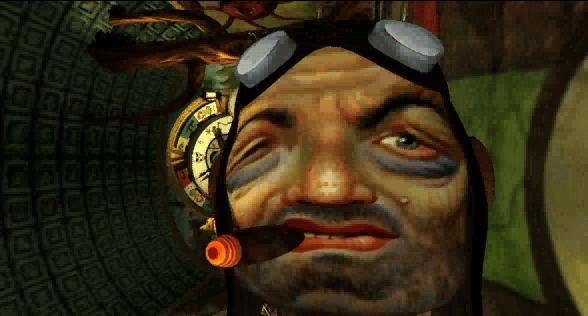
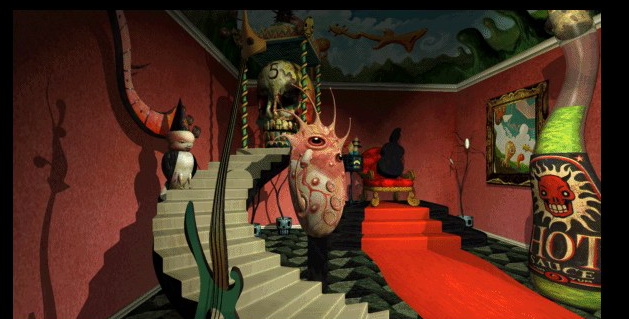


Let’s Play 9: Last Resort- Part 1
_________________

Eastern Mind: The Lost Souls of Tong-Nou (1994)
‘Eastern Mind is the product of Osamu Sato, an independent Japanese artist who attracted the attention of Sony Imagesoft after some critical acclaim for his music and video work. Sato is perhaps most recognizable for his work on the nightmare simulator LSD. He had great creative control over Eastern Mind, and its themes are fittingly personal. You play as Rin, a man whose spirit is taken by the soul-swallowing island of Tong-Nou. Rin borrows a soul for 49 days and, after receiving an amulet from a friendly snake, takes a trip to Tong-Nou to restore himself.
‘Up until this point, the game sounds like folklore, akin to the story of the trickster raven who steals the sun. All pretensions vanish when Tong-Nou is revealed to be Osamu Sato’s massive, green head floating in space. To get around, you have to climb into his head. Five minutes into the game, and it decides that the best way to depict an exploration of inner creativity is literally.
‘Rin can accomplish little at first, let alone enter the mountain where the kings of Tong-Nou have trapped his soul. To advance, he must die and descend into the Tree of Life. From within the roots, he can “transmigrate” into nine other lives from the four worlds of Tong-Nou: time, life, dreaming, and desire. Each represents a different part of Rin. Through these lives, Rin must collect the five elemental “magatamas” that contain his soul and, essentially, discover himself. Death is frequent but not penalized; going with the Eastern spiritual theme, death represents a new beginning and lets you reselect whichever life you want.
‘Apart from the batshit insane creative direction, Eastern Mind‘s greatest asset is its non-linearity. Each of the nine lives has a different objective which, while ostensibly based in a specific part of Tong-Nou, takes you on a whirlwind tour of the island. As long as you complete all nine at some point, you can follow whatever meandering path through the hub world that you want. At least half of the game’s content is optional, so you can pick and choose what you do to finish each life. To get one important item, for example, you can either find it in a chest or buy it with the aforementioned amulet. Or you can use that amulet as a Get Out of Death Free card.’ — Obscuritory

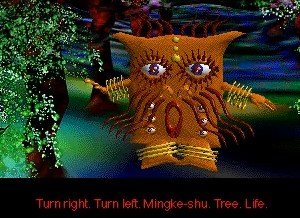
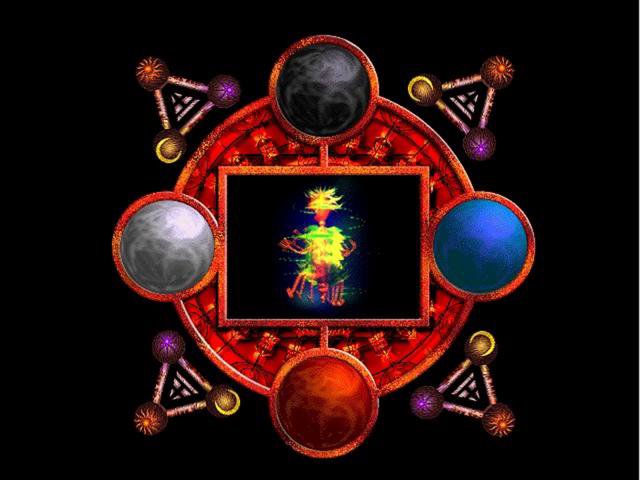
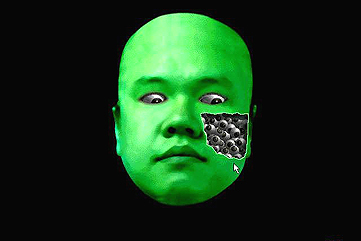

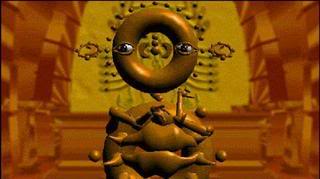


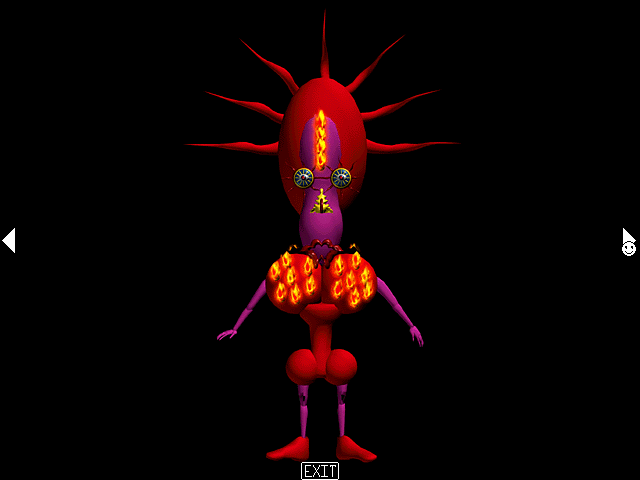
Intro
_________________
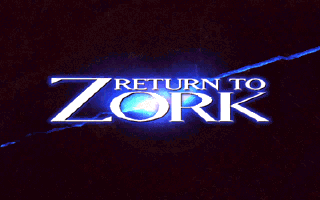
Return to Zork (1993)
‘Unlike the previous games in the Zork franchise, which were text adventures, Return to Zork takes place from a first-person perspective and makes use of video-captured actors as well as detailed graphics; a point-and-click interface replaced the text parser for the first time in a Zork game. The overall gameplay style was somewhat similar to Myst, although Return to Zork predated Myst by a few months. Unlike Myst, which had no extraspatial dimensions of functionality, Return to Zork featured multiple ways of interacting with each object in the game world, as well as with several non-player characters also present in the world via a menu which appeared on the left side of the screen. It also offered multiple ways to “complete” the game, which encouraged replay.
‘Among the actors who appeared in the game were a number of instantly recognizable (by face, if not necessarily by name) character actors as well as a number of well-known younger actors: Robyn Lively of Twin Peaks as “The Fairy”, Jason Hervey of The Wonder Years as “The Troll King”, and Sam J. Jones from the 1980 film Flash Gordon as “The Blind Bowman” and A.J. Langer of My So-Called Life as fellow Zork explorer Rebecca Snoot whom the player encounters on several occasions. Game designer, Doug Barnett, worked independently with Activision. Art designer Mark Long (co-founder/owner of Zombie Studios, Seattle, Washington) had several goals in mind to “make the game realistic” and “avoid things like mazes in text adventure games”, and “multiple ways to solve puzzles, and to finish the game.” In an interview in 1999, he stated these concepts:
‘(1) All of the puzzles in the game reference real, albeit esoteric, references to various cultures and archeological history and studies. A common example would be the exploration of the pyramids in Cairo, Egypt along with the mythology that surrounds it, but uncommonly known examples were chosen over better-known ones. Mark’s overseas duties in the U.S. Army (retired Major) combined with a year of historical research enhanced the puzzles that must be solved to finish the game. (2) Navigation is “always correct; if you move north then south, you are always in the same place. Solving mazes was overdone, dull, and annoying.” (3) There are multiple (“at least three”) ways to solve puzzles, as well “as a half-dozen ways to complete the game.” His reasoning: “I didn’t like games that you had to follow a single, specific, obfuscated path for each puzzle, and just one way the game could be finished.” This was contrary to text-based adventure games and the widely popular Myst series. It also “gave the player a reason to play the game more than once, trying to discover new ways to solve puzzles and to finish the game. Serious gamers said they had worked out dozens of combinations to complete the game.”‘ — collaged
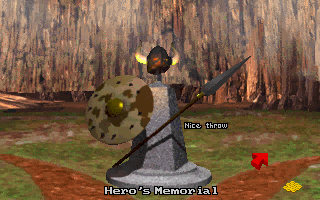


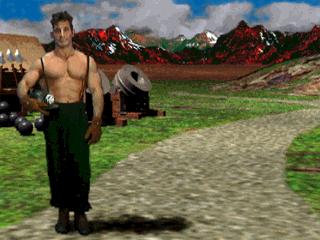
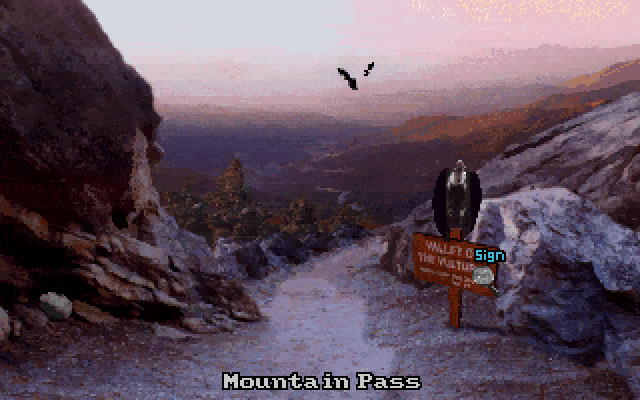
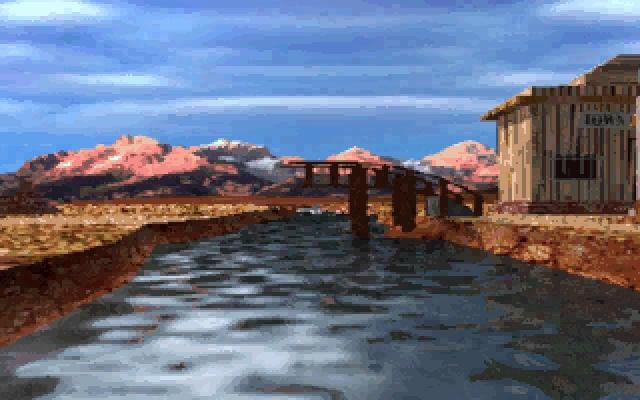
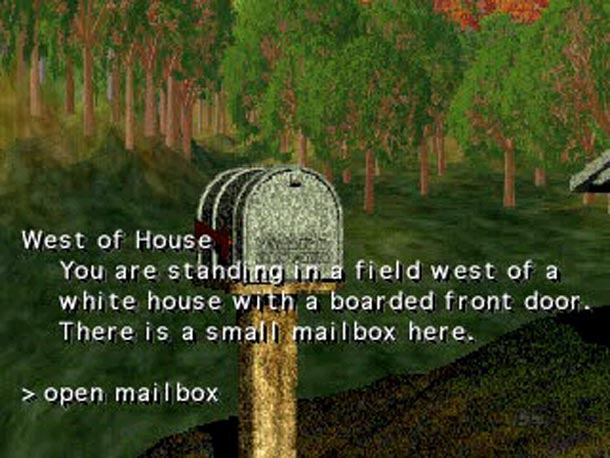
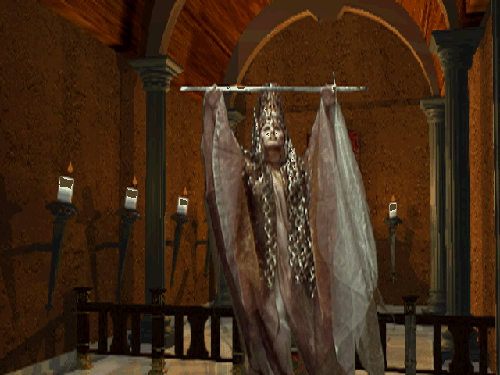
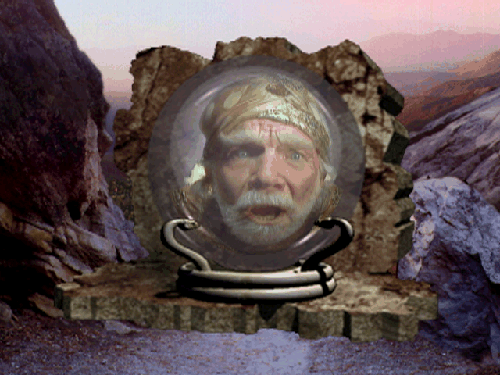
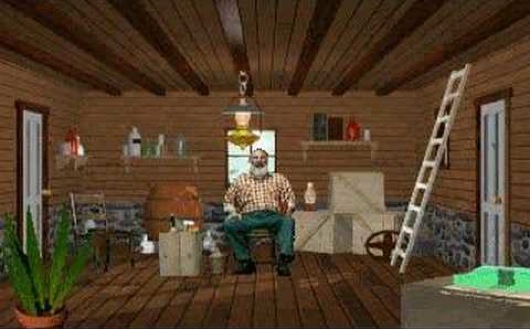
Trailer
_________________

Phantasmagoria (1995)
‘In some ways, Phantasmagoria is the quintessential 90s game, borrowing elements – intentionally or not – from some of the decade’s biggest phenomena. Released in 1995, it was smack in the middle of publisher Sierra’s adventure game heyday. Like CD-ROM sensation Myst, all the characters are rendered using full-motion video, while the environments are all composed of static, pre-rendered 3D backgrounds. And, like Mortal Kombat and Night Trap before it, Phantasmagoria’s realistic and often gruesome depiction of its characters stirred up controversy.
‘The story of Phantasmagoria is pulled straight from traditional horror tropes. A young married couple, Adrienne Delaney and Don Gordon, buy an old mansion located outside of what appears to be a coastal town in either New England or the Pacific Northwest. As her photographer husband begins converting a second-story bathroom into his personal darkroom, Adrienne decides to explore the house.
‘Players take on the role of Adrienne, controlling an FMV sprite of the actress who portrays her (tastefully dressed in another 90s phenomenon: high-waisted jeans). Once belonging to an eccentric 19th century magician named Carno, the house and surrounding grounds are strange to say the least, replete with bizarre torture devices, outlandish architecture, austere portraits, lots of secret rooms and one grab-happy haunted bed. Before too long, Adrienne goes poking around where she shouldn’t, uncovering a hidden chapel and releasing an ancient evil that promptly possesses her husband.
‘None of this is to say that Phantasmagoria is a perfect adventure game. Most of the death scenes are optional, for one. I missed two of them this time around, and wouldn’t even know they were there if it wasn’t for Google and YouTube. In fact, a great deal of the game’s content is optional. That’s a shame, as many players could miss a lot of the story, especially the bits about Carno’s descent into madness. And, while the full-motion video presentation is novel, some of the performances leave a lot to be desired. Don’s performance at the end of the game, when he finally goes full-on crazy, is positively eye-rolling.’ — joystiq.com
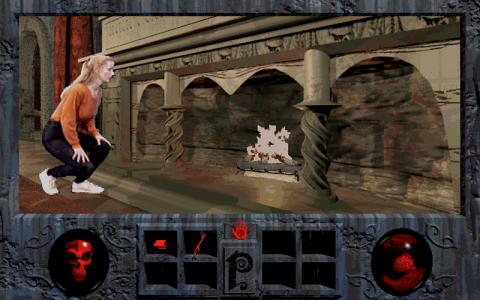
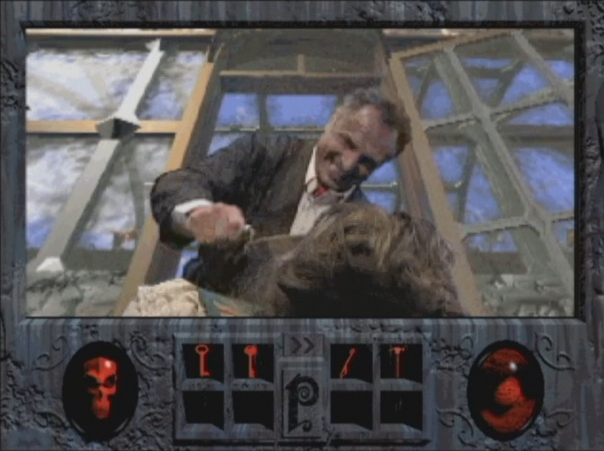

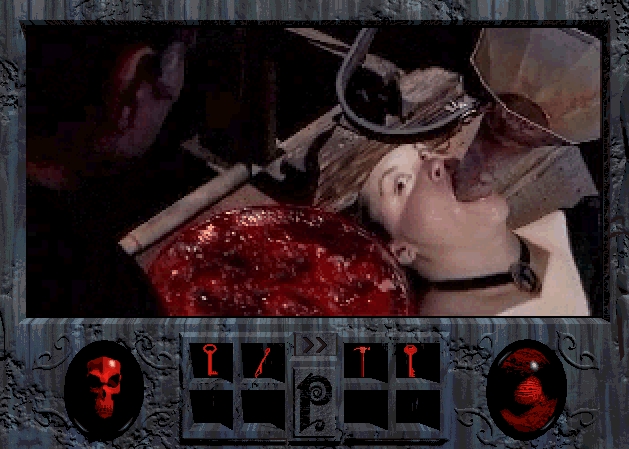
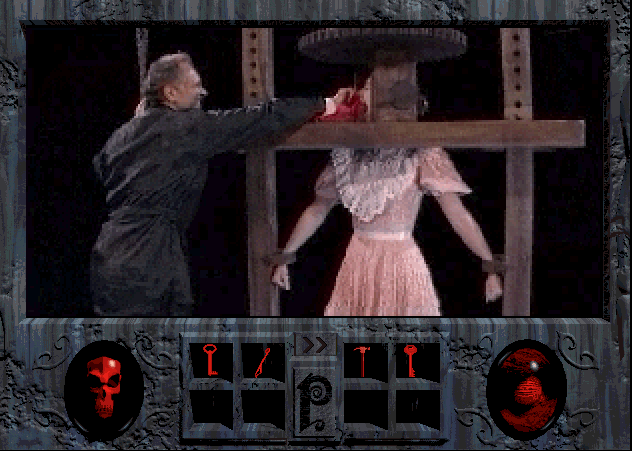

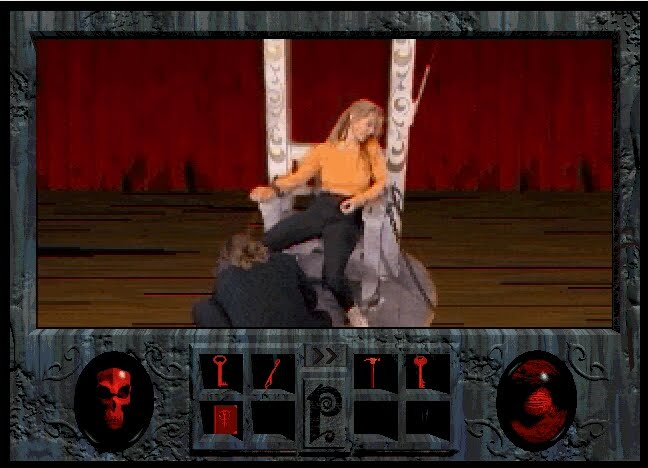

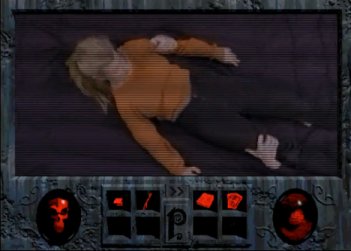
Gameplay
________________
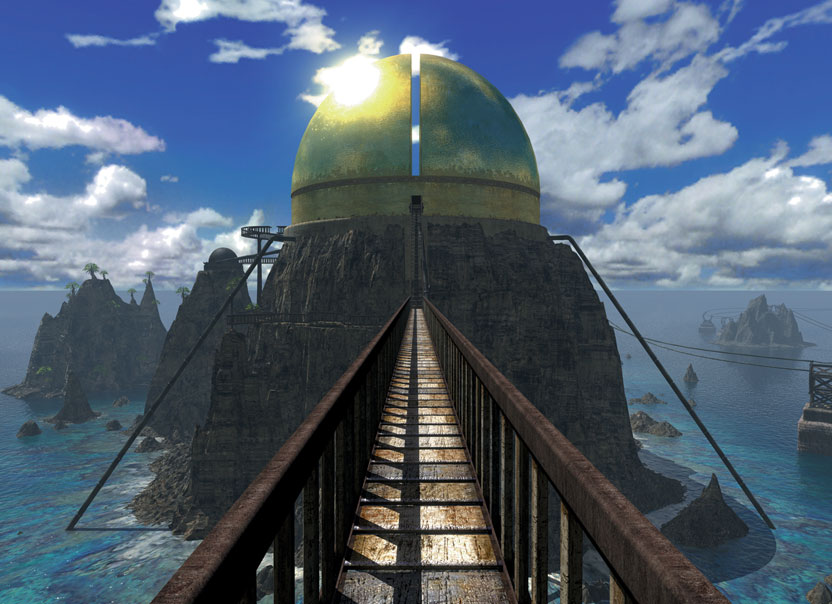
Riven (1997)
‘Developed by Cyan (now Cyan Worlds) and originally published by Broderbund, Riven was released on five CDs in 1997. It was later released on a single DVD-ROM with enhanced visuals and eliminated the need to swap discs. Development of Riven lasted over three years, and was the result of a larger budget and much larger development team than the original. Among the newcomers to the Myst creators was former Industrial Light and Magic employee Richard Vander Wende, who helped lend a unique artistic style to Riven in order to separate it from its predecessor.
‘The game earned high praise from fans and reviewers. Many fans consider Riven to be the best game in the series, and the most difficult, as well. With five islands full of interesting puzzles, intriguing story, and impressive visuals, it’s little wonder Riven was as much a success as the original Myst, selling 1.5 million copies in just its first year on the market.
‘Like Myst before it, Riven is a first-person, point-and-click adventure game set in gorgeous pre-rendered environments. The player explores the world of Riven by clicking on different areas of the screen in order to turn, walk, and interact with objects in the environment. Progress through the game could be considered non-linear, as there is no list of goals or objectives. Instead, players must explore the five islands of Riven to solve puzzles on their way to the story’s ultimate conclusion. Also like Myst, the game included a “Zip Mode”, for fast travel over previously explored areas.
‘The plot of Riven essentially takes place immediately after Myst ended – Atrus, the man you met in D’ni at the end of the first game and the owner of Myst Island – needs help, which is where the player – or the “Stranger” – comes in. Atrus’ wife, Catherine, is trapped on the deteriorating Age of Riven, and is being held captive there by Atrus’ father, Gehn. Details on Riven’s backstory, including the reason Gehn is trapped there, can be found in the first Myst novel, Myst: The Book of Atrus.
‘At the start of the game, Atrus gives you his journal, which he hopes will be enough to get you up to speed on what exactly is happening and what he needs you to do. He also gives you a trap book, which he’s afraid you’ll need in order to capture Gehn. Don’t use it yourself, or it’s game over. Atrus cannot accompany you to Riven himself, as he has to keep writing. He is desperately altering details of the Riven book in order to slow its deterioration. While this would perhaps imply that you only have a certain amount of time to rescue Catherine and get the heck out of Riven, this is only a plot element and has no effect on gameplay. Since Atrus cannot risk Gehn escaping from Riven, he unfortunately has to send the Stranger into the Age without a way out. The player thus has to find a way to signal Atrus once he has trapped Gehn and rescued Catherine, so that Atrus can come to the Age with a Linking Book to bring everyone back. Among various other elements uncovered throughout the game’s plot, the Stranger learns about the Star Fissure, a sort of portal found on the decaying Riven Age that leads – oddly enough – to the Stranger’s home of earth. This explains how the Myst book originally fell into the Stranger’s hands in the first place, and gives the Stranger a sense of hope: If he succeeds here, there’s a chance he can go home again.’ — Giant Bomb

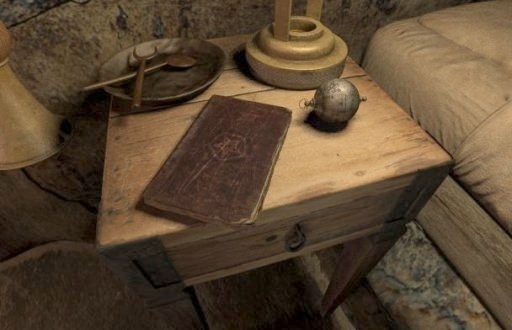
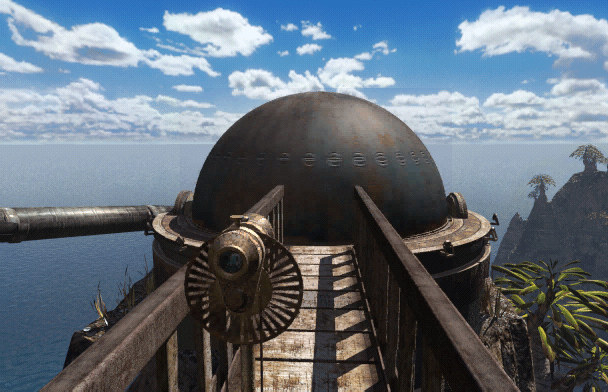
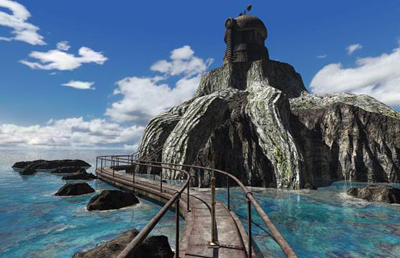

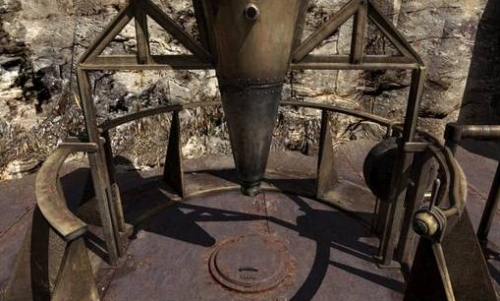
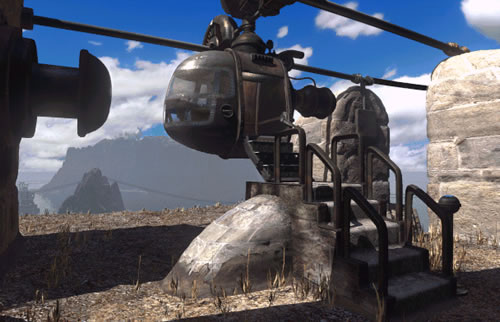


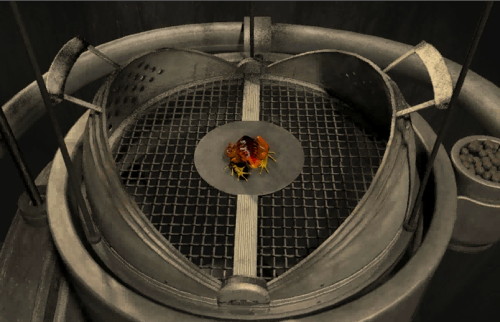
Longplay
*
p.s. Hey. ** _Black_Acrylic, Binge trigger, awesome. Thanks, I haven’t looked at William Bennett’s blog in ages. Everyone, _Black_Acrylic: ‘In case you’d not seen it, William Bennett’s blog here has lots of features about Giallo films and similar directors.’ William Bennett, i.e. late of Whitehouse and currently of Cut Hands, if the name rings a bell. ** Misanthrope, ‘The Barbarians’ is a pothead laugh riot fest classic. Maybe the Ukraine grain shortage is making people think practically. I think if a fiction writer used semicolons excessively, that could be interesting. As the world grows increasingly de-literate, it seems the semi-colon’s only hope for survival is as one of the two icons needed to form an old fashioned ‘wink’ emoji. ** David Ehrenstein, Is that true, ha ha? ** Tosh Berman, Well, let’s just say I wish you had a real presence in the film world then. Oh, I guess I thought ghosts were supposedly residue and that they’re stuck in the locations where they either died or maybe I guess spent the most meaningful or unhappy periods their lives? Although why would that be the case, I guess? Hm. Great ghost stories. My mom believed in them too. She used to tell us kids that there was this massive ghost that looked like a huge Halloween pumpkin that would appear over her bed like a dirigible. I’ve told this story before, sorry, but my only inexplicable experience that could be explicable if one believes in ghosts is that this young guy who was living at our family house for a while killed himself, gassed himself in his car on Mulholland Drive. For a while there was this suitcase full of his stuff that was going to be sent to his parents. It was leaning against a wall by my mom’s desk, and I was sitting in her desk one day and looking at the suitcase and thinking about the dead guy, and the suitcase just suddenly flew into the air and landed on the floor about three feet away from the wall. That was fucking weird, and I could never figure that out. ** Bill, The ‘Cannibal Holocaust’ score is kind of wonderful if you like that sort of thing. If you can at least give that project a few more stabs, I’ll be grateful. I have all kind of far fetched fiction plans that end being way too far for me, unfortunately. Tips … Maybe we should Zoom. That might be easier. Do you zoom or Skype or anything? Yes, the Peter Rehberg live record is really terrific albeit rather painful to listen to, of course. ** Dominik, Hi!!! Yes, emoji poems! That might be the solution. Emoji haiku! Call me crazy but I can really see that working well. I might just try to make one of them. What I liked about my yesterday’s love is that it seems perfect at first until you think about it, and then it starts to seem like hell on earth, ha ha. Visible farts, yikes! Talk about hell on earth. Or maybe if I think more about it, it’ll seem like heaven on earth, huh. Good one! Love coming to my rescue, and yours too if you need rescuing from anything, G. ** sean, Hey! Ooh, I’m going to sit down and concentrate and read that very carefully once I’ve dotted the p.s.’s final ‘i’, but I can already tell at a glance that it was well worth your effort, assuming your brain is still in one piece, of course. Awesome! Thank you so much! How’s stuff? ** Steve Erickson, ‘House on the Edge of the Park’ is quite good. You might just be able to hear Monday’s meeting way over there in NYC. The two places in Paris I know of that carry The Wire are Smith & Sons, Paris’s largest English language bookstore, which is happily three blocks from me, and the Centre Pompidou. I’m sure it’s sold elsewhere, but I always get mine at S&S. Very strange that no place sells it in NYC. Quite strange. ** Robert, Hi. It’s a kind of fun, ridiculous show: the crucifixion thing. The one time I watched ‘Cannibal Holocaust’ it was with a knowing friend who told me when the animal stuff was about to happen and when it was over so I could cover my eyes. I can’t take that shit. I’ve been a vegetarian since I was 15, and I get nauseous and freaked out if I’m sitting at table where someone’s eating lobster or even shrimp. Really happy you liked ‘Malina’, obviously. Being stumped in a new way is kind of the ideal effect from a book for me. So, yeah. What’s next? ** Okay. I was thinking about the 90s when ‘video games’ as ambitious forms came into being and when even popular games could often be very experimental and adventurous and innovative, and how that prioritising of aesthetically and formally really daring games has moved to the extreme margins of the gaming world, and I remembered that I made this post ages ago charting my favorite games of that era, and I thought I should restore it. Maybe if some of y’all were around and gaming on your computers back then, you’ll have some long lost faves of your own that you can toss back at me. See you tomorrow.




 Now available in North America
Now available in North America 
7th Guest was so great. And Loom.
Dennis, Right? “Hmm, no bread…let’s eat a human!”
I’ve never played a CD-ROM game. It’s been all console my whole life.
Semicolons have their place. Idk, let’s abuse those fuckers!
I’ve got to get a blood test tomorrow. Just a regular ol’ one, a check up. I hope I don’t forget.
Otherwise, I’m chilling this weekend. You?
I hope you have a good weekend.
Hi!!
Emoji haiku, haha! Yes! I think we’ve arrived at the ultimate version!
I’m so deeply sorry about the whole situation with your film. It’s an absolute nightmare that you have to keep working with him after all this and that you have to use your personal funds to save the project.
I’d be more than happy to let love direct all his rescuing powers on you right now! Love writing and directing a horror movie in which the protagonist does NOT yell, “Hello? Is somebody there?” as soon as they hear some strange sound in a dark room, Od.
Was never much of a gamer and 1990s CD-roms are defo not my specialist subject, but these screenshots do look nice and their narratives are intriguing. I know Dundee is now home to a massive computer game industry and there are fortunes to be made there.
Can you push the shoot date back to give yourselves more time? This situation sounds awfully awful, especially the fact that you can’t get rid of this guy even though he did nothing to help finance the film.
Archive.org has an interesting library of old software, including CD-ROMs, though I’ve found them hard to download.
The Cold Spring label has recently reissued an excellent double album from 1972, Don Bradshaw-Lester’s DISTANCE BETWEEN US. It has a creepy occult ritual vibe, with piano, pipe organ and percussion, like a folk horror score from Terry Riley.
I’m not much of a gamer, but I’d be up for trying some of these. One of the Eastern Mind images reminds me of Oursler’s work, ha. I also like how Phantasmagoria, for example, achieves its look despite the technical limitations of the graphics. I like that much better than the slick 3D animations that are common these days in similarly themed games.
Would love to chat more on your interactive fiction ideas. I’ll email you in a few minutes.
Bill
Hi Dennis, this is a sweet post, though I have to admit I hardly played your games. Growing up, I was very much into playing video games with my two brothers and some of our cousins. My fave games were WWE, Aladdin, Sonic, Crash Bandicoot, and Mortal Kombat – I admit I still play this one… But grew up playing all these on Sega, PC, and PS1/2/3/4. I still play Mortal Kombat on Switch, and not to brag but I’m fucking amazing at MK… I adore its harmless violence & it feels like home to me lol. Currently, nobody can beat me apart from my nephew.
Have a beautiful weekend xo
God, these are fantastic! I’ve definitely seen Dust somewhere before but I can’t remember where. These remind me (albeit in a sorta different vein) of these two games that came pre-installed on the old imacs back when I was a little kid that my brothers and I used to play: Marbleblast Gold, which is just really funny and it has these weird physics and sound effects that sound completely normal to me in this weird buried-deep-in-my-subconscious kind of way (no matter how long I go without playing that game my muscle memory is perfect whenever I go back home) and then Nanosaur, which is just hilarious, there’s a really great photo somewhere of me sitting on my dad’s lap at age one-ish playing that game. And I got it to run on the laptop I have now here https://github.com/jorio/Nanosaur I think.
That’s interesting, I don’t really get bothered at all whenever people eat meat around me. Is it just lobster and shrimp or is it everything? Not sure what’s next, I’m gonna knock out The Bell Jar real quick (due in no small part to ulterior motives) and then it’s either A Frolic of His Own or The Man Without Qualities in the hopes that I can finish those before I start working full-time. Plus I feel like I have to read Frolic before I decide whether or not it’s worth going to law school to salvage my self-respect in the eyes of my family.
Hi Dennis, this is a wonderful blog post, will you blog about your favorite Commodore64, Atari, and original Nintendo videogames?
In the 1990s my favorite CD-ROM games were return to zork, king’s quest V and others, quest for glory, Wolfenstein, Doom 1 and 2, Quake 1, Diablo 1, Warcraft 2, Dark Forces, alone in the dark, lemmings, worms, 7th guest, descent, Civilization 2, encarta’s mind maze, and the Carmen San Diego games.
One of my ex’s in the bisexual commune we lived in when we all lived in New Mexico helped design Myst, the Mortal Kombat CD-ROM games and animated the dragon for the Mortal Kombat film and did animation for Star trek TNG and deep space 9.
I hope you are able to get your film financed, filmed, edited, and released. Can you push back the shooting, or find a completely new and professional source for funding?
Who was the man who lived with your family who killed himself? Did you write your poem love comedown about him? The suitcase/briefcase experience is unexplainable. Nobody in my family believes in ghosts, demons, poltergeist type ghosts, hauntings, demon posession, etc. but we have never experienced anything like this.
Yes Laura Albert does seem like a horrible person. I am sorry you had to go through this with her, but it was a learning experience.